There are different state repositories for personal records in Ireland. Before the 18th century, any documents written by government officials in either England or Ireland were considered the personal papers of those the person who had written them, and due to this, many records were removed by their owners upon leaving office, which led to the loss of many historical documents as many of these could not be traced and located, and there was no guarantee the documents were stored properly, let alone archived at all.
Research your ancestors on MyHeritage
History of Archives in IrelandHistory of Archives in Ireland
Irish archives before 1922Irish archives before 1922
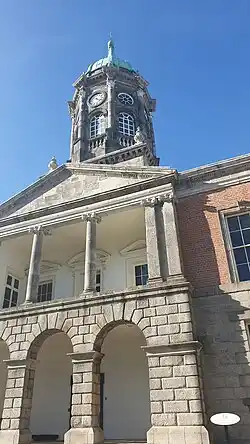
The State Paper Office was one of the earliest official archives in Ireland and had been created in 1702 as the repository for records relating to the administrations of the various Lord Lieutenants (the English monarch’s representative in Ireland) who before 1702 had taken all of their records with them on leaving office. The State Paper Office was located in Dublin Castle and survived as a separate entity attached to the Public Record Office of Ireland after 1922.[1] It was fully integrated into the National Archives in 1990. Most state papers dated before 1790 had been transferred to the Public Record Office of Ireland, and so were destroyed in the 1922 fire.[2] The surviving records of the former State Paper Office consist in the main of the archives of the Chief Secretary's Office and associated bodies, ranging in date from 1790-1924. The holdings of the former State Paper Office are itemised under the headings firstly of principal records, and secondly of records which were transferred at an earlier stage to the former Public Record Office of Ireland.[3]
The other significant archives in Ireland for this period, were the Public Record Office of Ireland, located in the Four Courts complex in Dublin. The Public Record Office of Ireland (PROI) was established in 1867 under the Public Records (Ireland) Act 1867, to bring together into a single modern repository the records of English government in Ireland.[4] Prior to the foundation of the PROI, Ireland’s public records were held in several distinct locations including the Record Tower of Dublin Castle, the Four Courts and the Custom House.

The new record office was a state-of-the-art premises located at the Church Street side of the Four Courts complex, designed to provide ample, secure storage for the records together with a modern public reading room. Its architects were Enoch Trevor Owen (d.1881) and Robert John Stirling (d. 1915) draughtsman of the Irish Board of Works.2 The construction took place between 1864 and 1867. The PROI consisted of two separate blocks, faced in cut granite. The first of these was the Record House, a three-storey building approximately 28 meters by 17 meters. This held the office of the chief archivist — whose title was Deputy Keeper of the Public Records of Ireland — together with the Registry Office and public Search Room, where readers could consult the public records. A caretaker lived on site in an apartment in the basement. The double-height Search Room was covered by a coved and glazed ceiling providing natural light to the readers below.[5]
Adjacent to the public Search Room was the Strong Room, whose windows were protected by iron bars. Here records could be stored safely overnight for readers who intended to return to consult them on the following day. The Search Room was also connected via double doors and a fire-break isolation zone to the six-storey repository known as the Record Treasury, a large block with a vaulted basement and a main hall at ground-floor level with five galleries above. The interior of the Record Treasury was a large atrium (approximately 45m by 28m and 18 m high), with light entering from an arcade of ten tall arched windows running along on each side, complemented by two windows at the north end of the repository throwing light into the central hall.[6]
Loss of public record office of Ireland in 1922Loss of public record office of Ireland in 1922

On 26th March 1922, officers of the Irish Republican Army who opposed the Treaty, held a convention in Dublin, in which they rejected the Anglo-Irish Treaty of 1921 and rejected the authority of Dáil Éireann (Irish parliament). On the 14th of April 1922, 200 members of Anti-Treaty IRA under Rory O’Connor occupied the Four Courts in Dublin, along with the Ballast Office and the Freemasons' Hall in Molesworth Street in Dublin.[2]
On the 22nd of June 1922 Sir Henry Wilson was assassinated in London by two members of the IRA. The assassination led to anger in Westminster and there was some discussion of British troops attacking the Anti-Treaty garrison in the Four Courts as a show of retaliation. However, it was felt that a better course of action was to increase pressure on the Irish Free State to deal with the Four Courts garrison.[7]
On 27 June the Provisional Government decided that the occupiers of the Four Courts had to be removed. Early in the morning of 28 June, the National Army surrounded the courts complex, and two 18-pounder field guns were dug in across the river from the Courts. At 3.45am an ultimatum was issued to the anti-Treaty leaders to evacuate the buildings or face an attack. Rory O’Connor and the other leaders ignored the ultimatum and no reply was made. At 4am the National Army opened fire on the courts with artillery borrowed from the British troops still stationed in Ireland.
National Army forces used the artillery to blow two holes in the exterior of the Four Courts to allow for an infantry assault. The siege ended less than 24 hours after these assaults, when, after fires and a great explosion, the garrison of the Four Courts surrendered, and were marched away into captivity.[8]
The explosion from the Four Courts could be heard up to 2 kilometres away. It shattered windows on Grafton Street, Dublin’s premier shopping street, scattered the ducks in St Stephen’s Green and sent people scurrying for what shelter they could find. A member of the Public Records Office staff, SC Ratcliff, recalled a scene of utter devastation afterwards. The glass and slate roof built in 1867 had fallen in and a huge crack emerged in one of the walls. The floor of the repository was piled up to 5m high with twisted ironwork and debris. The iron boxes containing many precious records had melted in the heat.[9]
In the aftermath of the fire, Free State sources claimed it had been caused by the deliberate detonation of a store of explosives or a landmine that had been placed in the basement of that building by the anti-Treaty garrison. However, more recent historical research has disproven this claim. Instead, the fire and explosion were caused by barrels of petrol stored in the ‘Headquarters Block’ before the beginning of the siege in preparation for setting fire to the building. This was apparently done on the last morning of the siege, Friday, June 30th, and the fire set off a large store of gelignite explosives in the west end of the building. The explosion spread the fire to the main Four Courts block and the Records Treasury, eventually causing their destruction. The reading room of the Public Records Office was spared destruction due to a fireproof partition between it and the Records Treasury. The previous day, National Army troops had captured the Records Treasury, which had been used by the anti-Treaty garrison as a munitions factory, and they had cleared the building of explosives. This fire is ultimately what caused the destruction of the PRO.[8]
It was the 17th of July before it was considered safe to begin retrieving documents from the rubble. James Morrissey, Assistant Deputy Keeper, led staff in gathering up fragments which were then sorted and identified. Everything retrieved from the wreckage was wrapped in brown sugar paper, labelled, and secured with string. The Records Office was made available in Dublin Castle for sorting and cataloguing the retrieved documents.[10]
The list of documents that were stored in the office’s record treasury departments are contained in a single 300-page manuscript, which fortunately survived the fire. This unpublished book, compiled in 1919 by Herbert Wood, the Deputy Keeper of the Public Records Office, was described as the “most depressing in Irish history” because it chronicles so many priceless documents that were incinerated in the fire. A digital copy is freely available on the National Archives of Ireland website.[11] Apart from a few fragments, the Irish Censuses of 1813, 1821, 1831, 1841, and 1851 were destroyed in the Public Records Office. The census records for 1861 and 1871 were destroyed separately after the census was taken. The census returns for 1881 and 1891 had been pulped during the First World War due to a paper shortage. As such these later census records were not in the Public Record Office at the time of the fire.[12]
Current archives in IrelandCurrent archives in Ireland
National archives of irelandNational archives of ireland
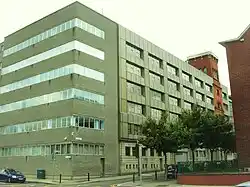
After the establishment of the Irish Free State in 1922, the State Paper Office and the Public Record Office continued to exist and function for over sixty years. Then in 1986 the National Archives Act abolished both bodies with their functions and holdings being transferred over to a new National Archives, which was also given responsibility for the preservation of the records of Departments of State and a range of central government bodies listed in a schedule to the Act.[13] A few years later in 1989 premises in Bishop Street in Dublin were assigned to the National Archives, Ireland. The premises of the former State Paper Office in the Record Tower at Dublin Castle were vacated in August 1991 and the headquarters of the National Archives, Ireland moved from the Four Courts to Bishop Street in September 1992.[14]
The National Archives of Ireland also continues to uphold the tradition begun by the PROI to acquire private collections that complement their holdings, including business records, medical collections, solicitors’ collections and some landed estate collections. Their collections are particularly useful for anyone interested in researching the political, social and economic development of Ireland from the 18th century to the present day. Many of the collections are also extremely valuable for family and local history research. Of particular value for genealogical research, their collections include the original surviving Irish census records, census search forms 1841-1851, the Tithe Applotment Books, Valuation Office house, field, tenure and quarto books 1824 – 1856, Soldiers’ Wills, 1914 – 1918 and the Calendars of Wills and Administrations, 1858 – 1922.[15]
National library of IrelandNational library of Ireland
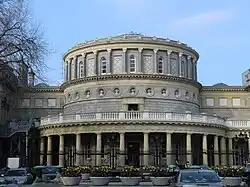
The National Library of Ireland, was established by the Dublin Science and Art Museum Act, 1877, and is the library of record for Ireland. As a result of this act, the majority of the collections of the Royal Dublin Society (RDS) were transferred to state ownership.
One of the most significant early collections was an expansive collection donated in 1863 to the RDS by Dr Jaspar Robert Joly, under the proviso that whenever a library for public use was established in Dublin, his collection would be donated to it. Dr Joly’s donation, which contained books, prints, music, manuscripts and other materials, formed the nucleus of the NLI’s collection, and remains vital to their collections to this day.[16]
The NLI was originally housed at the Royal Dublin Society's premises in Leinster House until the present building at 7/8 Kildare Street was formally opened in 1890. It was designed — along with the neighbouring National Museum of Ireland’s archaeology building — by the architectural practice of Thomas N Deane and Son.[17]
As the NLI and its collections continued to expand, the original premises were no longer sufficient. To facilitate its growing requirements additional premises on Kildare Street were acquired and a commitment was made to develop the site. Over the years, several new premises have been opened as part of the NLI. The Manuscripts Reading Room at 2/3 Kildare Street was opened in 1990. The National Photographic Archive, housing the NLI’s photographic collections opened in Temple Bar in 1998. In 2004, what was formerly part of the National College of Art and Design, was refurbished to include a new exhibition area, the Department of Prints & Drawings and a lecture theatre.[16] The NLI has many records and resources that can be used to trace Irish ancestors including Catholic parish records, property records, newspapers and directories. Alongside its collections, the National Library of Ireland also contains a free Family History Service.[18] The Office of the Chief Herald, formerly the Genealogical Office (GO), has been a part of the National Library of Ireland since 1943. The records of the Office are referred to as the GO manuscripts. You can view these in the Manuscripts Reading Room.[19]
Irish military archivesIrish military archives
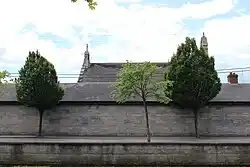
The Military Archives is located in Cathal Brugha Barracks in Dublin. The Military Archives has been the official place of deposit for records of the Defence Forces, the Department of Defence and the Army Pensions Board since 1990, as defined in the National Archives Act, 1986.[13] Their brief is to collect material from the foundation of the State up until the present day, including records from overseas missions. From as early as 1924, the National Army, recognising the importance of the War of Independence, undertook to preserve historical documents from that time. Some of the earliest collections preserved by the Historical Section include the Collins Papers, Civil War Operations and Intelligence files and Captured Documents (Civil War up to 1925), which continue to be made available today.[20] Their online collections include the Military Service Pensions Collection 1916 – 1923, the 1922 Irish Army Census, the Bureau of Military History (1913-1921), Easter 1916 An tÓglách Accounts (24 April 1916 - 29 April 1916), Oral Histories and United Nations Unit Histories (1960 - 1982).[21]
Valuation officeValuation office
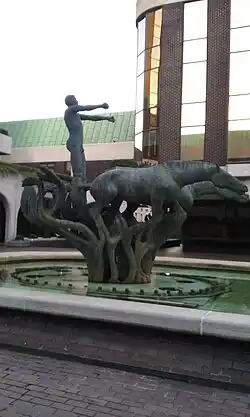
Land valuation records are among the most widely used of the sources used for Irish research, particularly Griffiths Valuation, also known as the Primary Valuation. However, it was merely the first in a continual series of land valuations carried out in Ireland. These valuation records are kept at The Valuation Office of Ireland, which is currently located in Block 2, Irish Life Centre, Abbey Street Lower, Dublin 1.[22]
The Valuation Office has a manuscript archive containing rateable valuation information of all property in the state from mid 1850s until the early 1990s; and commercial property only from that time. This archive shows the changes after the revision of properties and is recognised as a census substitute for the period from the 1850s to 1901 (the earliest complete census record for Ireland). The archive may be used to trace the occupiers of a particular property over a period of years. Maps of occupied properties were also created, which correspond to the map numbers in the margins of the Valuation Books.
Facilities for members of the public undertaking genealogical research are provided to view records and maps. Copies of entries in the valuation records and of the relevant map identifying the property location are available.[22]
Registry of deedsRegistry of deeds
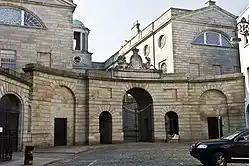
The Registry of Deeds is located in Henrietta Street, Dublin, Ireland and is a repository of records of wills, land transactions in Ireland and other deeds from 1708.[23] While the original purpose of the Registry of Deeds was to enforce rules limiting the land transactions of Catholics, even before the removal of these rules in 1782 many Catholics and representatives of Catholic families appear in the memorials. The Registry of Deeds is a rich source of genealogical information. Marriage and other settlements are particularly informative about family relationships. Many memorials involved people of modest means who were merchants and traders who registered deeds to provide some form of security of tenure.
A voluntary project, the Registry of Deeds Index Project was set up to provide a full names index to the memorial transcription volumes of the Registry of Deeds Ireland.[24]
Virtual record treasury of IrelandVirtual record treasury of Ireland
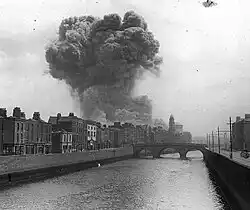
When the Public Record Office of Ireland was destroyed by fire in 1922, hundreds of thousands of precious historical documents relating to all aspects of Irish life were lost — apparently forever.[6] The Virtual Record Treasury of Ireland is a vast and growing treasury of replacement documents newly discovered in partner archives around the world, freely and permanently available online.
The Virtual Record Treasury of Ireland is the outcome of a five-year State-funded program of research entitled ‘Beyond 2022' funded by the Government of Ireland under Project Ireland 2040 through the Department of Tourism, Culture, Arts, Gaeltacht, Sport and Media. Led by Trinity College Dublin, Beyond 2022 has combined historical investigation, archival conservation, and technical innovation to re-imagine and recreate, through digital technologies, the archive of the Public Record Office of Ireland that was lost on 30th June 1922 during the destruction of Dublin’s Four Courts at the outset of the Civil War. Beyond 2022 is a project by Trinity College Dublin, in collaboration with the National Archives, the National Archives (UK), the Public Record Office of Northern Ireland and the Irish Manuscripts Commission. The project aims to create a virtual reconstruction of the Records Treasury of the Public Record Office of Ireland, which was destroyed during the Irish Civil War in 1922.[25] The Treasury contains online archives and, a card catalogue of additional records that still exist in Ireland, with the locations of those additional records that are not yet online. Some of the records useful for family history research include the 1766 Religious Census, Rent Roll of the pavement tax for Merrion Square (1776), Landed Estate Court Rentals (1850-1913), Grand Jury Map Collection, Grand Jury Presentments, 1759-1806, Grand Jury case bills 1808-1907, Statutory Census of Ireland, Manuscripts of John Lodge (1692-1774), deputy keeper of the records, Birmingham Tower, Dublin Castle and records of the Prerogative Court.[26]
See alsoSee also
Explore more about archives in IrelandExplore more about archives in Ireland
- How to trace your Irish genealogy on the MyHeritage Knowledge Base.
- Tracing your immigrant ancestor to Ireland webinar at Legacy Family Tree Webinars.
- Northern Ireland genealogy record collection at MyHeritage.
- Ireland, genealogy vital records collection at MyHeritage.
- Ireland family history record collection collection at MyHeritage.
References
- ↑ About the National Archives of Ireland
- ↑ 2.0 2.1 The Four Courts and the Irish Civil War
- ↑ Archives held in the National Archives of Ireland
- ↑ An Act to provide for keeping safely the Public Records of Ireland. 12th August 1867
- ↑ The Public Record Office of Ireland: The Story of a Building. Irish Architectural Archive
- ↑ 6.0 6.1 Construction/Destruction: The Public Record Office of Ireland (1867-1922). Virtual Record Treasury of Ireland
- ↑ Century Ireland - 22 June 1922: The Assassination of Sir Henry Wilson
- ↑ 8.0 8.1 Fewer, Michael. Under Siege: the Battle of the Four Courts.
- ↑ McGreevy, Ronan. Centuries of documents burned in the Four Courts in 1922. Now they’re being recreated.
- ↑ Reid, Zoe. Salvaging the Four Courts: Picking up the pieces of the Public Record Office Ireland in July 1922
- ↑ Herbert Woods, A guide to the records deposited in the Public Record Office of Ireland
- ↑ Rising from the ashes: salvaged material from the Public Record Office of Ireland, 1922
- ↑ 13.0 13.1 National Archives Act, 1986. Irish Statue Book
- ↑ About the National Archives. National Archives of Ireland
- ↑ Genealogy at the National Archives of Ireland
- ↑ 16.0 16.1 Our History. National Library of Ireland
- ↑ Furlong, Justin. A Magnificent Pile! A brief architectural tour of the main library building
- ↑ Family History Service. National Library of Ireland
- ↑ Office of the Chief Herald of Ireland. National Library of Ireland
- ↑ About Us. Military Archives of Ireland
- ↑ Irish_military_records
- ↑ 22.0 22.1 Genealogy. Tailte Éireann
- ↑ Registry of Deeds
- ↑ Registry of Deeds Index Project Ireland
- ↑ Beyond 2022: Ireland’s Virtual Record Treasury. National Archives of Ireland
- ↑ Genealogy Resources. Virtual Record Treasury of Ireland

